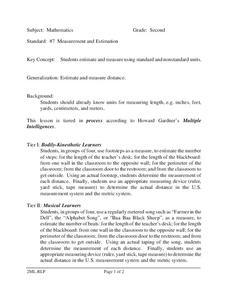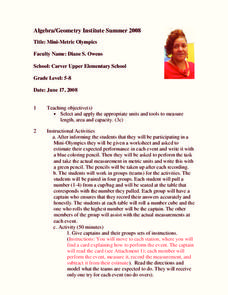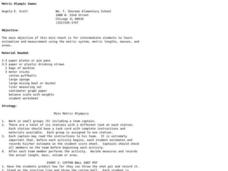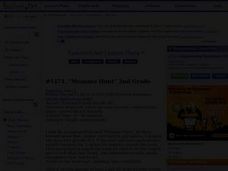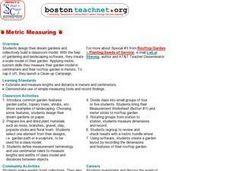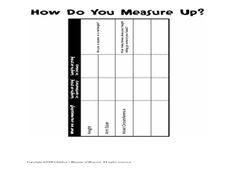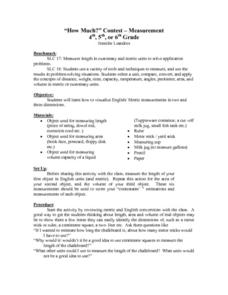Curated OER
Eating Through the Metric System
Seventh graders convert measurements in recipes to metric measurements and prepare the food items. They create a metric measurement cookbook.
Curated OER
Area and Volume Metric Conversions - Grade Seven
Middle schoolers investigate unit conversion. In this unit conversion lesson, students will build models of square and cubic centimeters using grid paper and generate formula tables for converting units of area and volume. ...
California Academy of Science
How Big is Big?
In a math or life science class, "mini-me" models are created with cardstock to reflect a 1:10 scale of students' bodies. Learners measure each others' heights with meter sticks, and then reduce the size by 10. After this exercise, they...
Curated OER
Shaquille O'Neal Hand & Foot Span
If Shaquille O'Neal wears a size-20 shoe, how big are his hands? Learners will use the average ratios of foot length to hand span to calculate the hand span of Shaq, but first, they have to collect the data! They will...
Captain Planet Foundation
Shape Shifters in the Math Garden
Combines mathematical measurement with gardening skills. Third graders hunt for worms in the garden and try to find the longest one. They also measure and weigh vegetables that they harvest from the garden, measure rainfall amounts,...
Curated OER
Making Metric And Customary Rulers
Students create a ruler for the purpose of measurement using the standard and metric systems. The rulers are of different lengths and are compared to one another. Then students make conversions of different lengths using both systems of...
Curated OER
Metric Meals
Sixth graders investigate metric measurements. In this metric measurement lesson, 6th graders explore mass, capacity, and length. Students examine graduated cylinders and balance scales to obtain measurements. Resources are provided.
Curated OER
Metric Me!
Students experience measuring things without the system of inches or millimeters. They utilize a ruler to measure or a body part to measure at least three body parts such as your ear height, finger length of foot width. Students...
Curated OER
Measurement and Estimation
Third graders create a table in order to record estimations and measurements of objects. In this estimation and measurement lesson plan, 3rd graders estimate and measure object's lengths, area, weight, and capacity.
Curated OER
The Amazing Inch and Measuring Up!
Fifth graders study the metric and customary systems of measuring length with rulers, meter / yardsticks, and tape measures. They determine area of polygons and surface area and volume of three-dimensional shapes. They list as many...
Curated OER
Length Lotto-Teacher's Notes
Students convert metric units of length, specifically meters, centimeters, and millimeters. In this lesson of converting measurements, students participate in various games which require them to put the measurements in order or convert...
Curated OER
Measurement and Estimation
Second graders explore estimation and measurement. In this estimation and measurement lesson, 2nd graders use footsteps to measure distances around the classroom. Students sing songs to measure the number of beats from one area to the...
Curated OER
Can You Measure Up!
Seventh graders investigate standards of measurement and metric units using a game to show the importance of standards of measurements. In this measuring lesson plan, 7th graders are grouped together and each group represents a foreign...
Curated OER
Mini-Metric Olympics
Learners participate in a Mini-Olympics with measurements. In this measurement lesson, students throw items and predict how far they will go. They measure the actual distance and find the difference between that and their estimate.
Curated OER
The Measurement Man
Students explore the measurements of capacity by constructing a creative project in the shape of a man. The man has body parts that represent different units of measurement and can be used to make conversions. This is highly concrete and...
Curated OER
Metric Olympic Games
Students participate in a metric Olympics. In this metric measurement lesson, students participate in 6 events that require them to predict, estimate, and measure lengths, masses, and area in metric units.
Curated OER
Measure Hunt
Second graders measure classroom objects using metric and English rulers to find object which meet preset lengths given to each small group. The group draws pictures of the objects they found meeting their preset limits and present them...
Curated OER
The Search for Centimeters
Investigate the length of various objects in metrics! In this measurement lesson, 2nd graders estimate and find the length of objects in the classroom using centimeters.
Curated OER
Now That's Using Your Head!
Explore linear measurement. Scholars will measure the circumference of their head and the distance they can jump. Information is recorded, averages are calculated, and a data table is completed. They then determine possible relationships...
Curated OER
Metric Measuring
Students design their dream gardens and work together to build a class model. They use software to create a virtual model. They only use metric measurements.
Curated OER
How Do You Measure Up?
Students measure their body. In this measurement lesson plan, students use a string to measure their height and the circumference of their head. They record this information on the worksheet provided and answer questions as a group.
Curated OER
Measurement: Worksheet 1: Grade 3
In this measurement worksheet, 3rd graders, using provided rulers, measure pictures of animals to determine their length. They estimate both length and width of given items and choose the correct answer from a list of multiple choice items.
Curated OER
"How Much?" Contest - Measurement
Students work with measurements of length, area, and volume capacity of a liquid. They watch a teacher demonstration of both English and metric units before they estimate and take actual measurements of assigned items a three different...
Curated OER
It Takes Ten
Review and use standard units of measure with your math class. They move from station to station estimating and measuring length, volume, weight, and area. At each station they estimate and measure, and then compute the difference...











